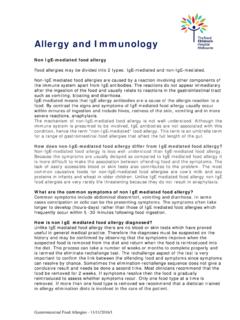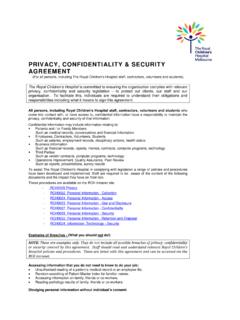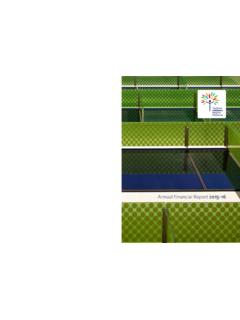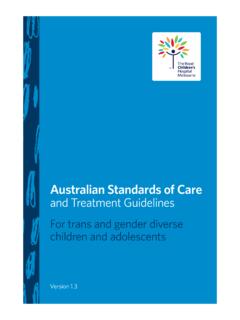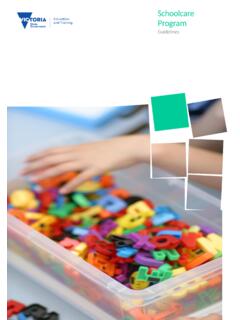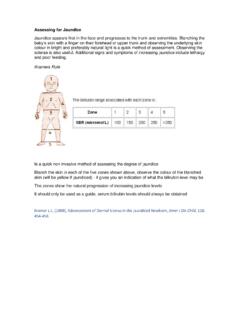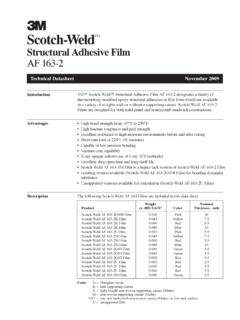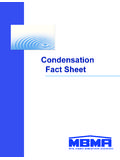Transcription of nursing services Dressings and wound management
1 Dressing typesExample of woundsApplication tipAllevyn (Foam dressing)Low to heavily exuding wounds such as: Pressure Injuries Leg Ulcers Burns Donor sites Skin tearsIf the foam is non- adhesive the dressing can be held in place with tape, netting, tubular retention bandage or undercast padding: If exudate levels are high this can cause the surrounding skin to macerate. To prevent this, skin preparation creams or protective barrier films may aid in protecting the surrounding skin. Alternatively you could consider a multi-layered absorbent dressing Foams can be used in conjunction with other Dressings to increase absorption. For example, you could combine an alginate or a gelling cellulose fibre with a foamAquacel Rope (Gelling cellulous fibre dressing)Moderate to highly exuding wounds for example: Pressure injuries Leg ulcersInfected wounds: There are gelling cellulose fibre Dressings which contain silver and are suitable for infected woundsWhen packing a cavity with a gelling cellulose fibre dressing it is advisable to leave a tail of at least 2cm at the surface of the cavity to enable easier removal of the dressing (see picture left).
2 Reason: The dressing may slip down into the base of the wound and be left there at the next dressing change, resulting in the dressing acting as a foreign body, which can result in delayed wound healing and possible wound infection: Gelling cellulose fibre Dressings do not need to be cut to the size of the woundComfeel Plus (Hydrocolloids dressing)Wounds producing low to high levels of exudate including: Pressure injuries Leg ulcers Surgical incisionsMay be used as a primary dressing or used as a secondary dressing with a gelling cellulose fibre or alginate against the wound applying a hydrocolloid the surface should be clean and dry: A skin barrier preparation wipe maybe used to aid skin protection The dressing should be measured to allow about a ( ) margin from the wound edge After you apply the dressing hold the dressing in place with the palm of your hand (the warmth will assist the dressing to mold to the skin) Try to avoid over stretching or too much tension when applying the dressing as this may cause trau-ma such as blistering or breaks to the surrounding skin If the edges of the dressing keep rolling the dressing may be secured with adhesive tape, netting, undercast padding or tubular retention bandageIntrasite Gel (Hydrogels)
3 Hydrogels can be used on wounds that have minimal to moderate exudateThe gel in the tube can be used on low to moderately exuding wounds and necrotic sloughy wounds including: Pressure injuries Sinuses Cavity woundsIf the surrounding skin looks fragile or compromised it might be beneficial to use a skin barrier preparation barrier cream such as zinc cream or a barrier wipe before applying the gel Apply a moderate amount of gel on the wound surface only. Try to avoid getting the hydrogel onto the good skin as it will result in macerating the surrounding skin causing skin breakdown Make sure that you note the manufacturer s recommendations for storage and single use application Some hydrogels contain preservatives and can be used for multiple applications up to 28 days. Check manufacturer s recommendations Hydrogel Dressings generally need to be changed dailyMelolin (Low absorbent dressing)Dry to medium exudating wounds: To protect surgical incisions To protect recently healed woundsMelolin is cheap and easy to use: Please remember to removed carefully as the dressing is only low adherent NOT non-adherent Do NOT use on highly exudating wounds, as if the fluid dries then the dressing may adhere to the (Silicone dressing)To prevent trauma to the wound and the surrounding skin.
4 To reduce pain during dressing removal Traumatic wounds Skin grafts or Skin tears Prophylaxis of skin radiotherapy burns and prophylaxis for pressure injuries Donor sites Leg ulcers Pressure injuries To aid in the treatment of hypertrophic scars and keloids Because silicone Dressings are quite tacky they can make application difficult. If you wet your fingers or forceps then handle the dressing this will prevent it from sticking The silicone sheet does not have to be cut to wound size. It can lie on the good skin and this can aid in dressing removalMepilex Ag (Silver dressing) Clinically infected wounds or critically colonised wounds To reduce the risk of wound infection and to treat infected wounds To provide sustained antimicrobial activity The wound must be producing enough exudate to activate the silver.
5 If the wound is dry the silver dressing should be moistened with water to activate the silver. Do not moisten with normal saline as this will deactivate the silver Do not wet/pre-moisten alginate or gelling cellulose fibre silver Dressings Avoid using zinc or paraffin on the wound as this may also deactivate or reduce the effectiveness of the silverTegaderm (Semi-permeable film )Suitable for superficial and shallow wounds, for example: Scalds Minor lacerations Suture lines Intravenous catheter sitesCan be used as a preventative measure for pressure ulcer development from skin be used as a secondary dressing to secure a dressing. The dressing should be measured to allow about 5cm margin from the wound edge Gently lay the dressing over the wound ; avoid wrinkling the dressing Try to avoid over stretching or too much tension when applying the dressing as this may cause trau-ma such as blistering or breaks to the surrounding skin When removing a transparent film from the skin gently stretch the dressing to break the contact adhesive bond, this will result in less pain for the patientTopper (Synthetic fibre gauze)
6 Suitable to Prevent infection To promote wound healing and patient comfort To prevent hypertrophy of skin or tissue at the pin sites for patients with an external fixator in situ Can be used for Pleural drains or medistinal chest drain More absorbent than cotton do not shed fibres Only use on minor wounds or as secondary dressingnursing servicesDressings and wound managementMore information go to the wound care clinical practice guidelines.
